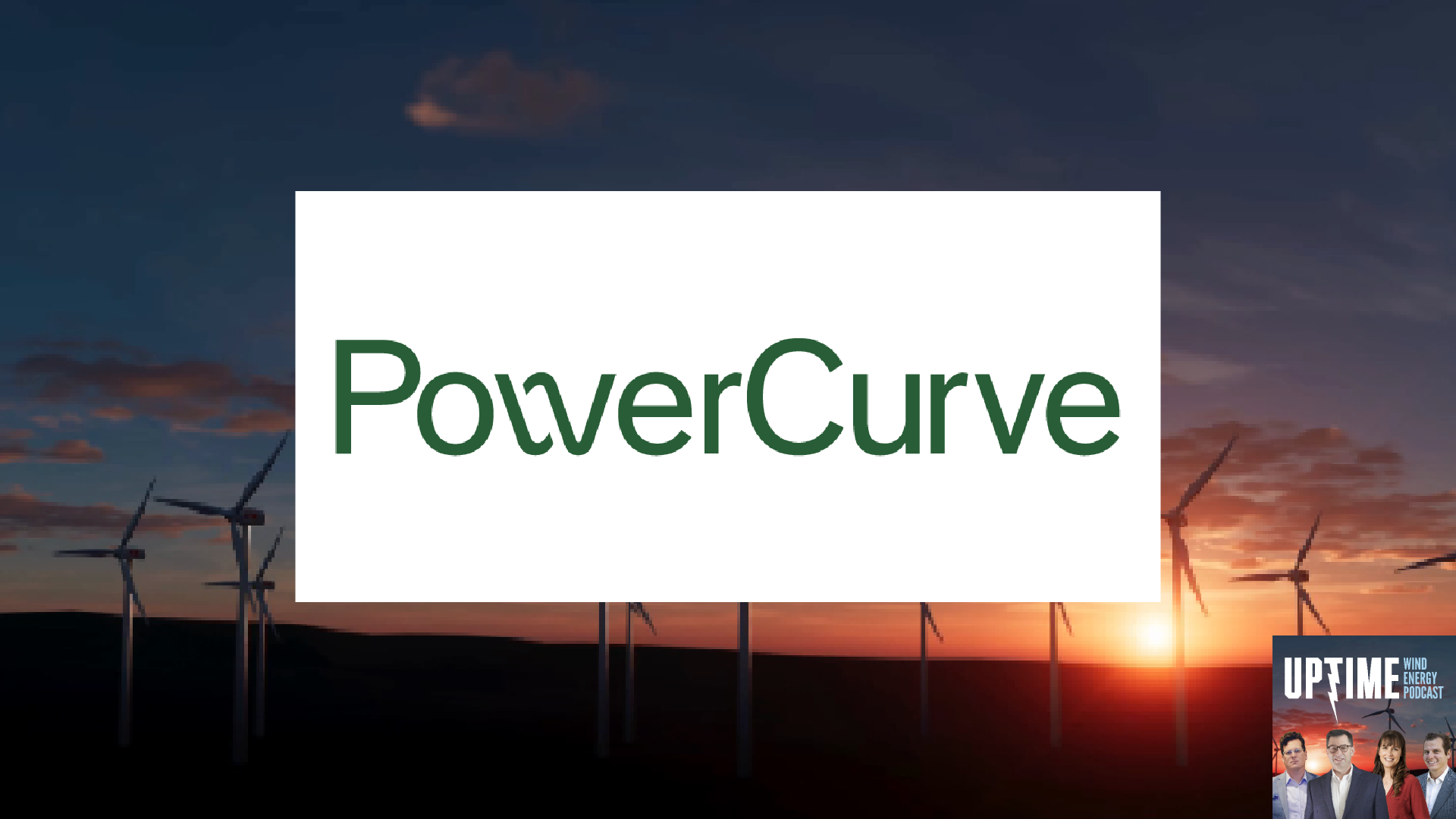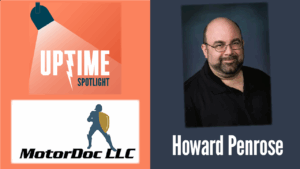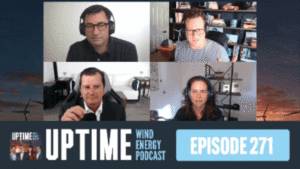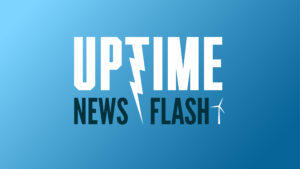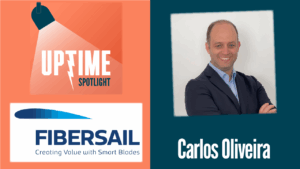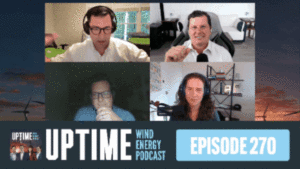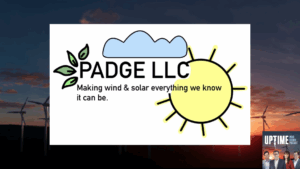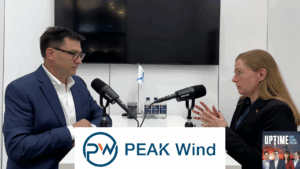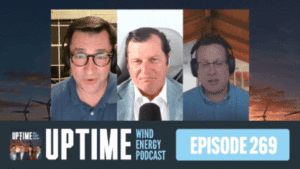Podcast: Play in new window | Download
Nicholas Gaudern, CTO at PowerCurve joins the show to discuss advanced blade upgrades that improve turbine performance and reduce noise. PowerCurve’s technology helps operators make smart decisions about maintenance and upgrades. Gaudern explains why combining repairs with performance enhancements is a cost-effective strategy that benefits both operations and community relations.
Fill out our Uptime listener survey and enter to win an Uptime mug! Register for Wind Energy O&M Australia! https://www.windaustralia.com
Sign up now for Uptime Tech News, our weekly email update on all things wind technology. This episode is sponsored by Weather Guard Lightning Tech. Learn more about Weather Guard’s StrikeTape Wind Turbine LPS retrofit. Follow the show on Facebook, YouTube, Twitter, Linkedin and visit Weather Guard on the web. And subscribe to Rosemary Barnes’ YouTube channel here. Have a question we can answer on the show? Email us!
Pardalote Consulting – https://www.pardaloteconsulting.com
Weather Guard Lightning Tech – www.weatherguardwind.com
Intelstor – https://www.intelstor.com
Allen Hall: Welcome to the Uptime Wind Energy Podcast Spotlight. I’m your host, Allen Hall, along with my co host, Joel Saxon. Today, we’re diving deep into the world of wind turbine aerodynamics and blade optimization with one of the industry’s leading experts. Our guest is Nicholas Gaudern, the Chief Technology Officer at PowerCurve, a company that’s revolutionizing how we approach wind turbine performance through advanced Aerodynamic solutions.
Now, Nicholas has over 15 years of industry experience and his journey includes significant roles at industry giants like Vestas, where he led the design of next generation blades. And as CTO of PowerCurve, Nicholas and his team are pushing the boundaries of what’s possible in wind turbine optimization.
They’ve developed innovative solutions like AeroVista, which helps operators make data driven decisions about blade maintenance and upgrades. Their work spans from custom designed vortex generators to trailing edge serrations, all aimed at increasing AEP while reducing turbine noise. So please welcome to the Uptown Wind Energy Podcast Spotlight, Nicholas Gaudern.
Nicholas Gaudern: Thanks, Allen. Yeah, good to see you as well, Joe.
Allen Hall: We have a lot going on in the United States in terms of rotors on the ground. Variety of reasons, but anytime that Joel and I are running through the Midwest, we see rotors down, and when I run into those people, I always ask, why are you not putting arrow improvements on your blade?
It is the lowest cost way to do it. There’s an opportunity there Nicholas?
Nicholas Gaudern: Yeah, there, there really is, and I find it very surprising as well, because whilst you can put upgrades on at lots of different points in a turbine’s life cycle, if you do have that roach on the ground it just makes everyone’s lives that bit easier, and also it’s going to save you a lot of money on installation costs.
So yes, I think it’s a great thing to be considering because you can be working on different parts of the blade at the same time. And if you’re going to increase the AEP with those devices you put on, you can consider that as a way of paying for some of the other work you might be doing while the rotor’s down.
Allen Hall: Yeah. And we’ve run into many operators that have talked to us about noise of all things in the middle of the United States where there’s not a lot of neighbors to them. But neighbors are concerned about the noise produced by the turbines and in very windy places. Yeah. like Kansas, Oklahoma, Texas, there is blade noise.
It’s there. And most of the equipment out in service does not have trailing edge serrations. And I’m beginning to wonder if that is trying to be, if there’s needs to be an adjustment made there that you may not technically need trailing edge serrations for noise quieting, but to be a good neighbor.
To everybody around you, you may want to consider it
Nicholas Gaudern: or especially if you have blades on the ground. I think we should see more serrations out on the blades because as you say maybe it’s not about a regulatory thing Maybe the turbine is producing a an acceptable noise level to the letter of the law in that place But it is about being proactive and being a good neighbor and I think now Serrations have been out there from lots of different OEMs, lots of different turbines.
To me, they’re a proven technology. Serrations work to reduce noise. And now the actual magnitude of that noise reduction can vary from turbine to turbine and site to site. But you should easily be looking at getting one and a half to two decibels of peak noise reduction if you’re applying serrations.
Joel Saxum: I would say almost all of the new turbines that we’re seeing, like Allen, you and I just took a trip last week, right?
And we were bombing through, we were up in Kansas, a little like right near Kansas. We went through Oklahoma and we actually ran into a two piece GE blade on the side of the highway. So we stopped to take some pictures of, cause of course that’s who we are. And that, that blade had serrations on it.
And almost every blade I see, or that you see going down the highway on a truck, it’s got serrations on it. So proven technology. People understand that it’s probably easier to do during a capex phase than applying these things on uptower. Now, Powercurve, from your guys, from your armchair, you’ve been putting dinotails on, we call them dinotails in the field, right?
Yep. Dinotail serrations. You’ve been putting these things on for years as a retrofit. You’ve also sold them in during the capex phase. And I’ve actually worked with you guys in the past, in my blade life during a repower which is, that’s the extreme version of what we’re talking about here.
When you drop a rotor, of course you drop a rotor, you’re going to drop a ton of them during the wind farm. Or you’re putting new blades up. It just makes sense to do it during those stages because Let alone the, what you’re doing for the neighbors, right? You’re keeping things quiet.
There’s also some efficiency increases with serrations too, isn’t there?
Nicholas Gaudern: Like with anything, there’s lots of ways to define efficiency. So with serrations, I think one of the big gains you can get is if you’re in a site where the turbine is curtailed. So if it’s having power reductions in order to reduce noise at certain times a day, often called noise modes.
And different OEMs will have different kinds of noise modes available. That can cost huge amounts of AEP. For every one decibel of noise reduction, you might be looking at a couple AEP loss, depending on the turbine and the specific noise mode. So you can imagine if you can apply serrations to a blade that are going to take a couple of decibels off, and that means you can escape a noise mode.
That can give you some massive gains in annual energy production. And yeah, as you say, Joe, we’ve been retrofitting serrations for a while now. We’ve done it on lots of different turbine models often models where the OEMs may not support that particular blade with a dedicated serration product.
And that’s where we can really help because we can design serrations for any Yeah,
Joel Saxum: I know working with you guys in the past on many projects there’s a really intense way of getting things done at Powercurve. It’s done the right way. So when you’re looking at whenever, if you ever watch a commercial and you see something cool like wind tunnels and race cars and stuff like that’s Nicholas’s daily life.
So is that you guys are out there getting 3d models of certain blades. You have a library of 3d models of blades, and that’s what you build your products off of, because it’s all about aerodynamics.
Nicholas Gaudern: It is. And it’s really important when you’re putting something on a blade that you know how it’s going to perform over the whole blade system.
So when you put a serration on its job is to reduce noise. But it’s job is also to not break the blade that you’re putting it on. It’s job is also to not fall off. So it’s very important when you design a serration that you tailor it to the blade you’re working with so that you’re not changing the loads in a bad way.
And it should also be designed to interact with that blade. So it’s a robust product over the lifetime of the turbine. So there are lots of different ways you can design serrations. Some people claim that serrations can directly increase AP. That’s not an untrue statement, but it’s quite a subtle statement because serrations Can act a bit like flaps on the back of a blade if you angle them relative to the flay.
And if you angle them, maybe you can get some more lift. And maybe you want more lift. But sometimes you may not want more lift. I’m very cautious of making blanket statements around serration as directly increasing AP. Because there’s some subtleties around how you do it and whether you are concerned about loads or not.
As a general rule, at Powercurve we design our serrations to be load neutral, i. e. they won’t increase or reduce power. Their job is to reduce noise. Now, if there’s scope to do other things, we can talk about it, but yeah, please think about serrations as a noise reduction tool. If you want to change lift of a blade, there are some smarter ways to do it that are a little bit less invasive.
Allen Hall: Because The serrations by the different manufacturers are not all the same. We obviously see them from the side of the road or if you’re out of sight. They just look like triangles on the back of a turbine blade. But they’re not all made the same. And some more recent news from PowerCurve is big noise reductions because of the specific design that PowerCurve has invested in.
Do you want to talk about that a little bit? What is special about your serrations versus the generic ones you typically see outside?
Nicholas Gaudern: I think what we found over the years and through doing a lot of wind tone testing as well, is that there’s a lot of very subtle features on the serration and a combination of different kinds of subtle features can give some quite significant changes to the noise reduction performance.
So you have to think about every aspect of a serration, not just the general shape of the tooth, and most serrations are saw teeth, as of some some definition. But what is the edge thickness? What is the chamfer of the thickness down to that edge? What’s your base plate thickness? How do you seal it relative to the blade?
All of these things matter when it comes to noise reduction. So I think We’ve tried to just pull together as many beneficial features as we can and then just be careful when we’re tailoring it to a blade. But what I will say is that if someone tells you that they truly understand how a serration works, they’re very probably lying.
The physics is incredibly difficult around noise reduction and noise generation on aerodynamic devices. And we understand it more than most, sure, but we can’t model it fully. We can’t run CFD models to accurately predict how noise is being generated and scatters and how we can manipulate it subtly.
There’s a lot of active research in the field, which is exciting. It means that there’s space to, to change and to innovate. But it also means that sometimes serrations don’t work if you’re not careful. Yeah, I think we, we take a very practical approach where we base it on a lot of wind tone testing with real components and then testing in the field.
So we’ve been on a lot of turbines now and we’ve measured up to three and a half decibels of noise reduction on some of our trials with our products.
Joel Saxum: How are you measuring that? What’s the mechanism for measuring decibels? Did you go, is it like go out a hundred meters, 200, 500 meters microphone?
How does that work? Okay.
Nicholas Gaudern: Yeah so like lots of things with wind turbine testing, there’s an IEC standard for noise testing, and that lays out different microphone positions, different amounts of data capture you have to achieve to satisfy that standard. Again, like other other standards, there are flaws in it, there’s uncertainties, but.
If you want to get a measurement that people are going to accept, then you would follow the IEC noise measurement guidelines, which is, yeah, positioning microphones different places, gathering data.
Allen Hall: Let’s talk about the fundamentals of serrations for a minute. I think people really understand how they work, what they are trying to accomplish in the first place.
On the back edge of a blade, you have high pressure and low pressure that are mixing very rapidly, and that causes a slapping effect, right? And then As the blade is moving downwards, not upwards, but downwards, a lot of that noise is projected forward. That’s where the vast majority of noise comes from on the downward blade.
It doesn’t seem obvious at the time. It’s like it on the upward side should be the one, but
Nicholas Gaudern: I think what you I mean, there are lots of noise sources on the turbine. And there’s also more than one aerodynamic noise source on a blade. I think most people accept that the dominant noise source, aerodynamic noise source in most blades is what we call trailing edge turbulent boundary layer noise.
So that’s just that turbulent boundary layer interacting with a blunt edge being scattered out into the atmosphere. And that’s what we’re hearing as noise, but there are other noise sources as well, but they don’t seem to be as important from the experimental work that’s been carried out over the years.
So yeah, with a serration, you’re trying to, you’re trying to modify that scattering mechanism effectively. Your flow is traveling over the blade surface. Boundary layers developing interacts with the trailing edge. So boundary layer health and boundary layer development are really important to noise, but serration doesn’t change that.
The serration is dealing with what happens when it gets to the trailing edge. But that’s where things like vortex generators can come in. Because if you have a boundary layer that is not healthy, not happy, it’s starting to separate off the back of the trailing edge. The noise is going to increase dramatically.
So we will always look at whether there’s benefit in combining things like VGs. With serrations to get a even better noise reduction effect.
Allen Hall: Because a serration design and installation depends upon what the airflow is across the surface of the blade, because you’re mixing high pressure and low pressure on that trailing edge.
So the way those serrations are designed are meant to handle a specific set of airflow. I’ll call it. And if that airflow deviates quite a bit as we see blaze age and become full of leading edge erosion, your serrations on the back end are not doing what they should do because the airflow is just completely different.
No they can’t deal
Nicholas Gaudern: with
Allen Hall: it. And that’s where the vortex generators come in because they’re controlling the airflow that goes over the serrations. You want to talk about how those two work together where if serrations and actually vortex generators are a package, That they work together to control the airflow.
Nicholas Gaudern: Yeah. And I think the point you just made about leading edge erosion is a really important one because. Leading edge erosion harms the boundary layer health. It harms the quality of the flow over the aerofoil surface. It means more turbulent flow, typically leads to more drag, more noise, lower AEP. And if you apply vortex generators, what you’re aiming to do is to re energize the boundary layer, re energize that flow over the blade to make sure that it remains fully attached.
And ideally that you don’t have such a thick boundary layer by the time it hits the trailing edge. So basically VGs are working on the source of the problem, if you will, the boundary layer health and serrations are working on the other part of the problem, which is what happens when we’re trying to scatter that.
Noise out into the atmosphere. So the nice thing about them is they do some together. So they’re working on different parts of the problem. VG is upstream, serration is downstream.
Allen Hall: They work in tandem. A lot of operators, when they have leading edge erosion, they’ll say the blades are a lot noisier than they used to be.
Of course, there’s a lot more turbulence coming off the leading edge. The question is what you should do about it. And are there things that can control it? The simple way, the way that I think it should be done is when the blades are on the gun, you put VGs and serrations on as a match set, and then when the leading edge erosion happens, and it inevitably will, it doesn’t impact the noise so much.
Obviously, going ahead and fixing the leading edge is a way to do it, but you can’t do that every year.
Nicholas Gaudern: No, you can’t. And, fixing the leading edge you have to think about leading edge. Degradation in two different ways. A positive, not as in good, but a positive is in building up material and a negative is in removing material.
So erosion removes material. Dirt, bugs, algae, frost, whatever, that accumulates material. But both are bad aerodynamically and even if you’ve got the best leading edge protection in the world. It probably can’t do much about the contamination side, the accumulation side, only the degradation side.
Allen Hall: At PowerCurve, you’re not just providing generic parts for a generic turbine blade, serrations, vortex generators.
You actually have CFD analysis, a lot of wind tunnel experience that goes along with that. The new product, which is AeroVista, is there to help with those design elements. And I think it’s a really fascinating approach. I don’t know if everybody’s seen this, but you can just put an AeroVista power curve into Google and you’ll get to the right page.
Now AeroVista is actually looking at your specific blade, your specific kind of leading edge your very specific kind of damage to then predict what Power you’re losing, how much, also generally how much noise it’s making, so that you can put the right set of vortex generators, the right kind of serrations on your blade.
Do you want to explain how that process works?
Nicholas Gaudern: Yeah. So AeroVista is something that has been out there for for a year or so now, and the whole idea is that we take existing drone inspection data for blades that tells us very clearly where all the damages are on the blade. And we combine that with a very.
High fidelity aerodynamic model of that specific blade type. So if we bring those two things together, what it allows us to do is to calculate the expected ammunial energy production loss due to all the blade degradations, the blade damages. So whenever you have anything on a blade that means it doesn’t look like it did when it was new, it will reduce AEP, whether that be a crack, erosion, dirt bugs, whatever.
And each of those damages will have a unique aerodynamic signature as to how much it will change the lift and the drag of that specific slice of the blade. So what we’ve been working on is a method that will calculate that loss for every different kind of damage along a blade surface. And we build the models by actually taking the real blade geometry.
So we’ll go out into the field, we’ll carry out a laser scan of a blade, And that allows us to get the kind of as built shape of a wind turbine blade. And every blade model is different. So even if it’s a hundred meter rotor, if it’s from Vestas or Siemens, aerofoils will be different and the whole plan form will be different.
And that means it will react differently to erosion. So it’s simply not good enough to say, Oh, this hundred meter rotor is damaged like this. Therefore the AP loss is this. You have to actually look at the aerodynamics of that specific blade. So Avista is an automated tool. It will link to databases such as those you might find from drone inspector, Nerf labs, sky Spec Robotics, these different companies.
And it will take all of their tagging data. It’ll combine it with the aerodynamic model we’ve made, and then it will calculate the a EP loss based on all the damages that have been identified. The idea being that you can then prioritize where to spend your money as an operator. We speak to so many operators where they have a budget and they’ll use that budget through the year, but they didn’t necessarily know how to make the most of that money.
And if you’ve got a hundred turbines on the site, you can only fix 20. Which 20 do you fix? If structurally they look much of a muchness. Erevist will tell you where to target the money to recover the most energy by either repairing or refurbishing the blades or by installing upgrades, things like VGs.
Allen Hall: So the process for a customer sort of looks like this. I have existing SkySpecs images. I send them to PowerCurve. PowerCurve analyzes them and says this is the right configuration, vortex generators, trailing insurations for your turbine. Oh, that all makes sense to me and also helps me identify what turbines to go after for the most power production.
That all makes sense to me. So what does the process look like of installing VGs and trailing insurations? What is involved
Nicholas Gaudern: there?
Allen Hall: The
Nicholas Gaudern: process is pretty straightforward, really. You have to Measure up the blade. You have to mark up the blade with with the positions that we specify in in the manual that we’ll give you.
You then have to prep the blade surface. Pretty basically, a bit of sandpaper to get rid of any contamination and just key the surface mechanically a little bit. Wipe it off with standard blade surface cleaner, something isopropanol based. And then we specify a Methacrylate to component adhesive to attach our products to the blade.
So it’s a wet adhesive. And the reason we spec the wet adhesive is that means they’re not coming off.
Joel Saxum: It’s the good stuff. The good stuff.
Nicholas Gaudern: It’s the good stuff. Exactly. And it’s really important that they can stay there for the entire lifetime of the blade. Now, I’m not saying that some tape solutions can’t be good as well, but we have seen a lot of components that have come off when they’ve only been taped on.
Joel Saxum: Yeah, that’s something that Allen and I talk about with blade repair, blade, operators and stuff all the time, especially like strike tape, same thing, right? When you put a blade add on, it’s only as good as its installation. You can do all of the wind tunnel testing you want and all of this high fidelity, everything.
But if it’s not installed right, it’s no good. So that I’ve seen your guys manuals and putting them into the field. It easy. It’s easy for technicians to do. And the fact that you’re specking the exact consumables, that works fantastic. I love it.
Nicholas Gaudern: And we work with the technicians themselves. We’re not in the business of just handing over A cardboard box and a piece of paper.
We need to go and work with the technicians directly. We need to talk to them. We need to walk through the manual, show them videos, share them photos. And we’ll often be live on call when those technicians are on site. So if they have an issue. They can, WhatsApp us, they can call us, show us what’s happening and we can help.
Joel Saxum: I absolutely love that approach. It’s the same thing that Allen and I do. And I know from my experience with PowerCurve on projects, one of the things that you guys do as well is send us the installation reports the day that they’re done so we can do some QA, QC and make sure that the team’s got it right.
So that way, as we move forward, we’re not, there’s no, no issues.
Nicholas Gaudern: Yeah, exactly. We just, there’s always a learning curve, right? No one can do something perfect. Straight off the bat. So it’s about making sure we, we learn and get the process down as quickly as possible. And we find typically that the techs we’ve worked with can get these devices on very efficiently.
And once they’ve done one or two turbines, they’re off and running and they can work through a site very efficiently.
Allen Hall: And there’s so much happening in the aspect of aerodynamics on blades and aftermarket upgrades on blades. It’s amazing. And PowerCurve is leading that charge. If you want to check out PowerCurve’s offerings, just go to powercurve.
dk and you can, all the cool things are on their website. If you want to get a hold of Nicholas, you can find him on LinkedIn, just Nicholas Gaudern, PowerCurve, and he’ll pop right up and connect with them. Because if you need help with your turbines and producing more power. Nicholas is your guy to reach out to.
So Nicholas, thank you so much for being on the podcast. Appreciate all the time you spend with us teaching us about aerodynamics. It’s wonderful.
Nicholas Gaudern: Thank you. Yeah. Great talking again. Nice to be back.



